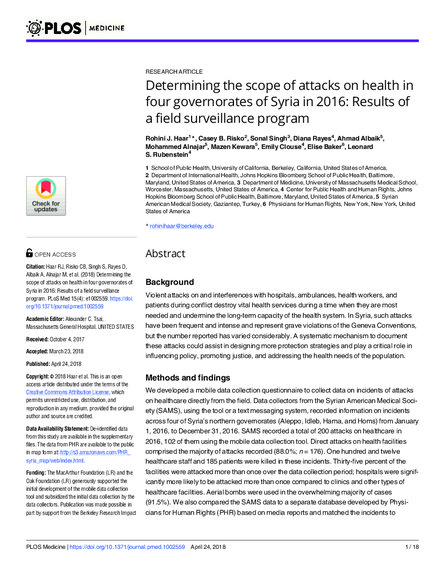
Violent attacks on and interferences with hospitals, ambulances, health workers, and patients during conflict destroy vital health services during a time when they are most needed and undermine the long-term capacity of the health system. In Syria, such attacks have been frequent and intense and represent grave violations of the Geneva Conventions, but the number reported has varied considerably. A systematic mechanism to document these attacks could assist in designing more protection strategies and play a critical role in influencing policy, promoting justice, and addressing the health needs of the population.
We developed a mobile data collection questionnaire to collect data on incidents of attacks on healthcare directly from the field. Data collectors from the Syrian American Medical Society (SAMS), using the tool or a text messaging system, recorded information on incidents across four of Syria’s northern governorates (Aleppo, Idleb, Hama, and Homs) from January 1, 2016, to December 31, 2016. SAMS recorded a total of 200 attacks on healthcare in 2016, 102 of them using the mobile data collection tool. Direct attacks on health facilities comprised the majority of attacks recorded (88.0%; n = 176). One hundred and twelve healthcare staff and 185 patients were killed in these incidents. Thirty-five percent of the facilities were attacked more than once over the data collection period; hospitals were significantly more likely to be attacked more than once compared to clinics and other types of healthcare facilities. Aerial bombs were used in the overwhelming majority of cases (91.5%). We also compared the SAMS data to a separate database developed by Physicians for Human Rights (PHR) based on media reports and matched the incidents to compare the results from the two methods (this analysis was limited to incidents at health facilities). Among 90 relevant incidents verified by PHR and 177 by SAMS, there were 60 that could be matched to each other, highlighting the differences in results from the two methods. This study is limited by the complexities of data collection in a conflict setting, only partial use of the standardized reporting tool, and the fact that limited accessibility of some health facilities and workers and may be biased towards the reporting of attacks on larger or more visible health facilities.